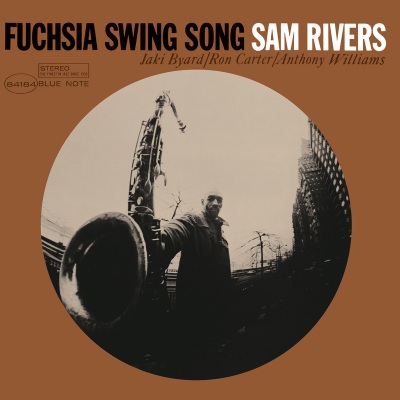
Fuchsia Swing Song
by Thom JurekRecorded in 1964 immediately after leaving the Miles Davis Quintet, Sam Rivers' Fuchsia Swing Song is one of the more auspicious debuts the label released in the mid-'60s. Rivers was a seasoned session player (his excellent work on Larry Young's Into Somethin' is a case in point) and a former member of Herb Pomeroy's Big Band before he went out with Davis. By the time of his debut, Rivers had been deep under the influence of Coltrane and Coleman, but wasn't willing to give up the blues just yet. Hence the sound on Fuchsia Swing Song is one of an artist who is at once very self-assured, and in transition. Using a rhythm section that included Tony Williams (whose Life Time he had guested on), pianist Jaki Byard, and bassist Ron Carter, Rivers took the hard bop and blues of his roots and poured them through the avant-garde colander. Today, players like Joshua Redman, Branford Marsalis, and James Carter do it all the time, but in 1964 it was unheard of. You either played hard bop or free; Davis' entire modal thing hadn't even completely blasted off yet. The title and opening track is a case in point. Rivers opens with an angular figure that is quickly translated by the band into sweeping, bopping blues. Rivers legato is lightning quick and his phrasing touches upon Coleman Hawkins, Sonny Rollins, Coleman, and Coltrane, but his embouchure is all his. He strikes the balance and then takes off on both sides of the aisle. Byard's comping is actually far more than that, building in rhythmic figures in striated minors just behind the tenor. "Downstairs Blues Upstairs" sounds, initially anyway, like it might have come out of the Davis book so deep is its blue root. But courtesy of Byard and Williams, Rivers goes to the left after only four choruses, moving onto the ledge a bit at a time, running knotty arpeggios through the center of the melody and increasingly bending his notes into succeeding intervals while shifting keys and times signatures. He never goes completely over the edge as he would on his later Blue Note dates. The most difficult cut on the date is "Luminous Monolith," with its swing-like figure introducing the melody. Eight bars in, the syncopation of the rhythm sections begins a stutter stem around the time and then the harmony with Byard building dense chords for Rivers to jump off of. On the Connoisseur Series CD (shame on Blue Note once again for making some of its best outside records "limited editions"; titles like this should be as readily available as Horace Silver's Song for My Father, but the label had been playing it ever so safe for a while and making fans buy the limited number of titles over and again) there are alternate takes of "Luminous Monolith" and three more of "Downstairs Blues Upstairs," making it a very worthwhile look at the entire session. This is a highly recommended date. Rivers never played quite like this again.
